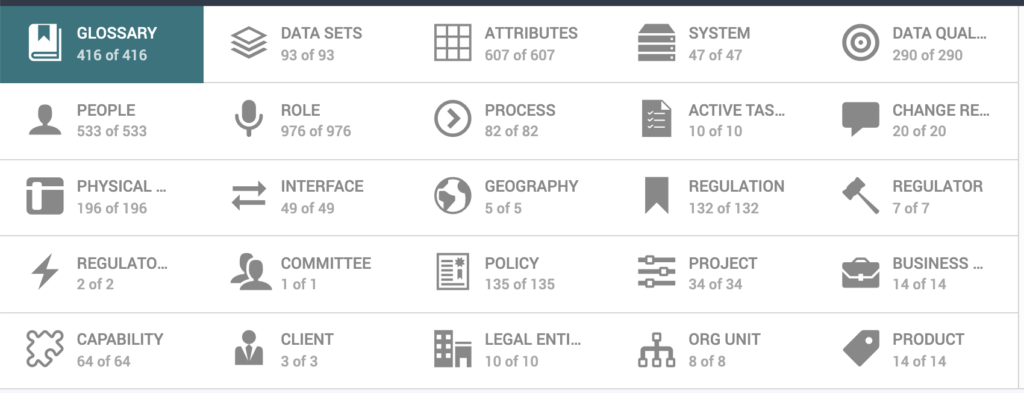Building on an Agile Data Governance Framework
Last Published: Sep 27, 2022 |
Where to begin?
Governance is far more than just keeping a good glossary of business terms up to date. In fact, governance should bring together all sorts of different data assets and perspectives. From glossary and data inventories, to processes and policies and organizational views, there is a whole lot to think about.

There will inevitably be competing priorities when any company first embarks on their data governance journey. Different teams will want different things documented, in different ways. Quite often, the need for governance is triggered by a particular initiative, sometimes regulatory, sometimes not. Typically, the first problem most organizations encounter is not knowing where to begin: not just in terms of content, but in terms of the types of content and how to document it. There are two ways to approach this when starting from scratch— and both approaches have their issues:
- Building a framework up front
- Lots of lead time for requirements gathering will delay governance plans
- Need to involve stakeholders too early may hurt long-term support
- Building from a specific use-case leads to narrow models, customizations for further projects become inevitable
- Building a framework as you go
- Reactive rather than proactive
- Inconsistencies will emerge in way things are created, making the tool less intuitive
- Alignment across silos is impossible without planning, so customizations become inevitable
Where does Customization get you?
Customization can sound appealing. The idea of unlimited flexibility may be tempting if you have never been burned by it before, but customization has a lot of unintended consequences. From maintenance issues to problems with integration, to confusion among the end user community—an overly customized tool will drive your total cost of ownership way, way up, while breaking engagement with your stakeholders. One bank that experienced this found that customization quickly became the norm rather than the exception, and they eventually realized that they had set themselves up to fail as a result.
Existing Framework
So how about considering a third option: using a tried and tested metamodel, that is both fixed enough to provide you with guidance and consistency, but also flexible enough to be agile?

The powerful thing about using the existing framework, is that you are in essence being guided by decades of experience in data governance. The 25 facets shown above are not industry-specific, nor are they tailored to any particular size of organization, yet they are reused across the hundreds of different companies we have supported. This is not to say that every company must use every facet, or that every facet will be used in the same way or to the same extent. Rather, it is simply giving you the basis to begin where you need to, and then allowing you to grow in the way you would like to.
Put another way, businesses of all sizes and varieties have more in common than they have differences, and a common framework that can factor in lessons learned along the way can be a huge head start. The facet model is not without flexibility, the majority of facets have types within them which allow you to define your assets in a more granular sense, but ultimately configuration rather than customization provides the flexibility you need.
Key Advantages
Leveraging this carefully thought out metamodel will bring you three key advantages:
1. The value of the data will be exposed through business context
Although we may start from the angle of satisfying a regulatory requirement, this is not the sole purpose of governance. Adoption and engagement are what will keep governance alive (learn more about this here), and the best way to drive this is to move beyond the focus on data to its usage. The metamodel we provide not only encourages documentation of data definitions, systems, and lineage for their own sake, but in fact draws in business users to connect these to processes, projects, and capabilities—thereby exposing the value of the documented data.
2. The stakeholder communities will relate to that context and maintain it
The right person to answer your question isn’t always the owner of the data definitions. It may be the person who wrote the policy applied to that data concept. It may be the person who is using that data concept every day in the context of a process. It may be the project manager who has just launched a new initiative related to that concept. Allowing communities to build up around these items and solve problems collaboratively will enable governance to become self-sustaining.
3. The consistency of documentation will allow for intelligence
When talking about using an existing framework, rather than building out a new metamodel, the exercise becomes mapping what you know using the basis of what is already there. This approach encourages reflection and consistency. So instead of creating one asset type for a legal basis and yet another for the purpose of processing, you are more likely to recognize that these could both be types of policies. Rather than adding custom field on definitions (as well as on systems) to indicate special category data, you will see that a connected policy will do twice the work with half the maintenance (as demonstrated here).
Even though consistency across the organization is often a key driver for DG initiatives in the first place, this original goal is often lost. It’s critical to strive for consistency within a governance tool, not only in alignment on definitions, but in general. Without a common basis, it becomes impossible to build intelligence, but with it, the possibilities are endless. Because successful automation depends on consistency (for more about enabling automation at scale, click here), how can you automate if things are documented so inconsistently?
Weighing the Options
So, what option will work best for your organization? The answer to that question will depend how much work you want to do yourselves and how much you are willing to learn from the work of others. The framework has evolved over many years, with hard-learned lessons built into its very design. If you are convinced that you have nothing in common with other companies looking to run governance programs, then you may truly have to start at the beginning. However, we think you’ll find you have more in common with everyone else than you think!
To find out more about how our automation and scale capabilities can reduce manual effort in your organization, register for the webinar, “Informatica Intelligent Differentiator Series: Agility,” or visit the Data Governance Standards: 4 Intelligent Differentiators page.








